‘As pretty a thing as I have ever seen’: animal encounters and Atlantic voyages, 1750–1850
Q3 Arts and Humanities
引用次数: 1
Abstract
ABSTRACT During the course of long voyages through the Atlantic Ocean – on their way to Africa, Asia and Australasia – British travellers experienced a variety of novel natural phenomena: the heat of the tropics, storms off the Cape, the beauty of shipboard sunsets, and unfamiliar constellations in the heavens. But it was the maritime animals that shared their shipboard space and inhabited the waters of the surrounding Atlantic that elicited the most sustained and detailed commentary from sailors and passengers. Animals were an integral part of these voyages. They travelled with passengers, as pets, curiosities and even speculative investments. The sea surrounding the ship was a veritable menagerie, encouraging travellers to speculate about the nature of the ocean and its inhabitants. They marvelled at strange creatures, compared them with familiar species, and collected them as specimens. As well as inspiring wonder and fear, encounters with maritime animals marked the journey from domestic and familiar to strange and unknown, expanding mental horizons in the process. Drawing on a wide range of first-hand accounts, this article explores the role played by maritime animals in marking the passage of travellers through the Atlantic in the Age of Sail.“我见过的最美的东西”:动物邂逅与大西洋航行,1750-1850
在穿越大西洋前往非洲、亚洲和澳大拉西亚的漫长航行中,英国旅行者经历了各种新奇的自然现象:热带地区的炎热、好望角的风暴、船上日落的美景以及天空中陌生的星座。但是,正是那些与他们同住在船上、生活在大西洋周围水域的海洋动物,引起了水手和乘客们最持久、最详细的评论。动物是这些航行中不可或缺的一部分。它们和乘客一起旅行,作为宠物、好奇心,甚至是投机性投资。船周围的海洋是一个名副其实的动物园,鼓励游客猜测海洋的性质和它的居民。他们对奇怪的生物感到惊奇,把它们与熟悉的物种进行比较,并收集它们作为标本。与海洋动物的邂逅不仅激发了惊奇和恐惧,还标志着从熟悉的家庭到陌生和未知的旅程,在这个过程中拓展了精神视野。这篇文章借鉴了大量的第一手资料,探讨了海洋动物在航海时代旅行者穿越大西洋的过程中所扮演的角色。
本文章由计算机程序翻译,如有差异,请以英文原文为准。
求助全文
约1分钟内获得全文
求助全文
来源期刊

Journal for Maritime Research
Arts and Humanities-History
自引率
0.00%
发文量
0
期刊介绍:
The Journal for Maritime Research ( JMR ), established by the National Maritime Museum in 1999, focuses on historical enquiry at the intersections of maritime, British and global history. It champions a wide spectrum of innovative research on the maritime past. While the Journal has a particular focus on the British experience, it positions this within broad oceanic and international contexts, encouraging comparative perspectives and interdisciplinary approaches. The journal publishes research essays and reviews around 15-20 new books each year across a broad spectrum of maritime history. All research articles published in this journal undergo rigorous peer review, involving initial editor screening and independent assessment, normally by two anonymous referees.
 求助内容:
求助内容: 应助结果提醒方式:
应助结果提醒方式:


